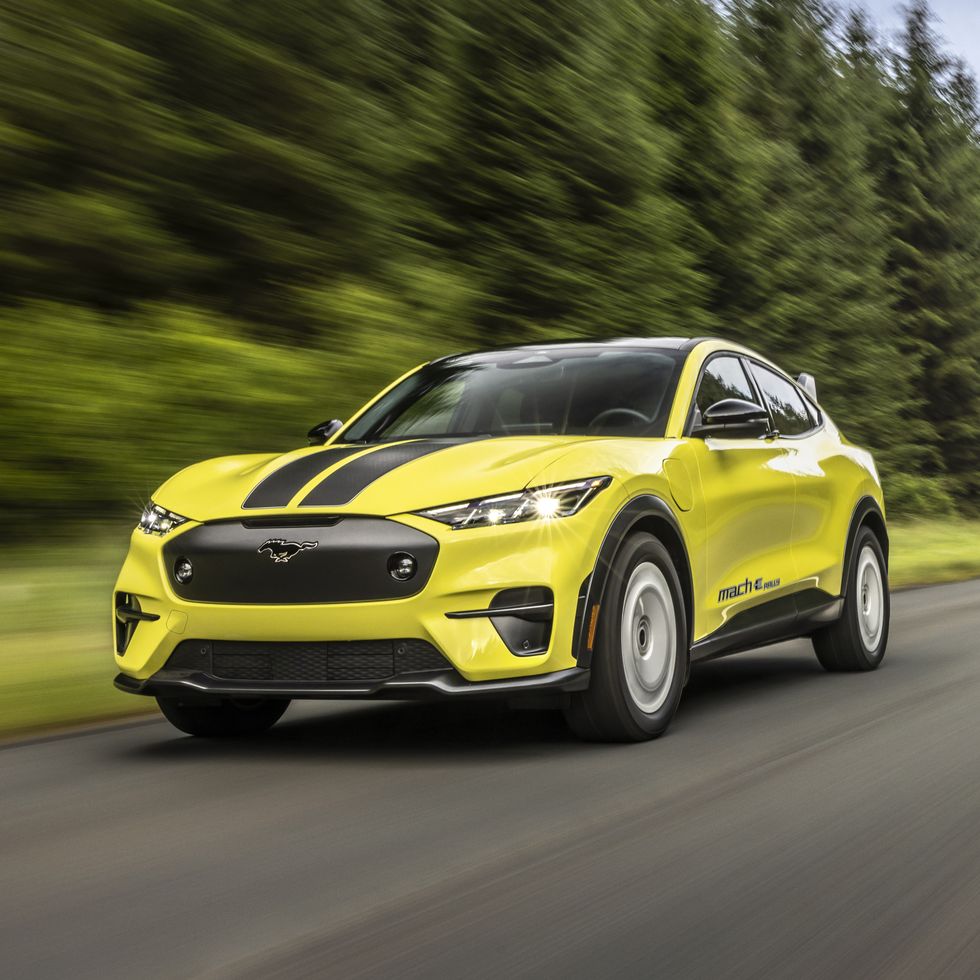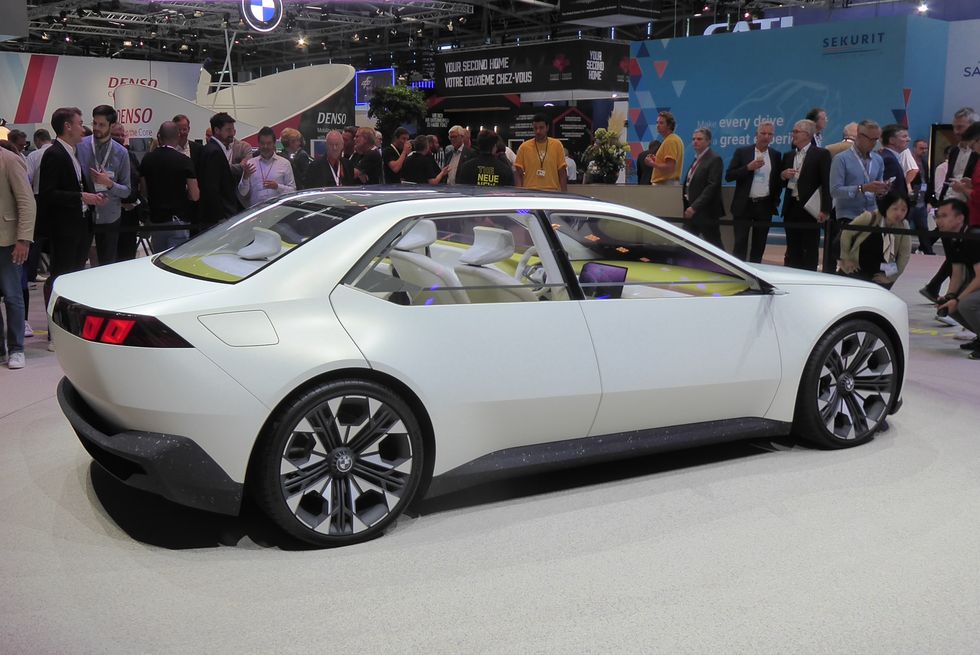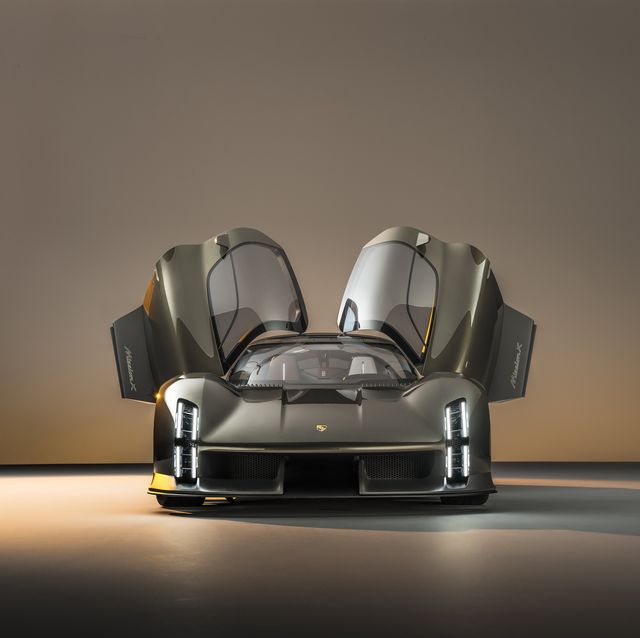- Dozens of automakers showed their electric wares at the IAA Mobility show in Munich this past week, including several familiar legacy nameplates like Ford, Porsche, BMW, Opel, and even MG.
- Plenty of Chinese companies were present, too, including BYD and Dongfeng.
- Participation from non-automakers included hydrogen suppliers and electronics suppliers.
MG is back! Well, not in the U.S., but the venerated British sports car brand—now under the ownership of leading Chinese automaker SAIC—is once more a strong seller in Europe and elsewhere in the world.
The company offers a series of SUVs in gas, plug-in hybrid and battery EV forms, and its MG ZS was the third best-selling vehicle in Australia in July, with nearly 4000 delivered.
MG went back to its roots at the IAA Mobility auto show in Munich this week. The car with pride of place on the company’s stand was the Cyberster concept, a very racy two-door convertible with gullwing doors. The production version of the car should appear in Europe by the end of next year, with an approximately 300-mile range from an all-electric drivetrain.
The Cyberster has the looks of a mini GT, and the only thing borrowed from the traditional sports cars of the 1960s is the octagonal badge.
MG product manager Fabian Ulbrich said that the car was styled at the company’s design studio in London, and will likely offer the choice of a 64- or 77-kilowatt-hour battery. A dual-motor version could have 530 horsepower and race to 60 miles per hour in less than three seconds.
Ulbrich noted that VW is SAIC’s joint venture partner in China, and that the company “knows how to build cars with high quality and in big numbers.”
The driver falls into the low Cyberster, but overall entry is actually quite easy through those electric scissor doors. Once seated, there’s a wraparound three-part screen, with some controls on a separate console display. The automatic shifter is also console-mounted. Bose provides the audio. The level of fit and finish is quite high.
The British press says the Cyberster, in only fully equipped, high-end models, will start around £50,000 ($62,000). It could be a European hit, but is at least so far not slated for U.S. sales.
Some other IAA Munich highlights:
- The show, rather expensive to enter, nevertheless made accommodations for the general public with free exhibitions all around the city, displaying new models and offering test rides.
You could get your bicycle washed, take a spin in an e-bike, or simply gawk at forthcoming electric entries such as, on an open-air Ford stand, the Explorer EV (produced in Germany on a VW platform, and available mainly in Europe beginning next year) and the Mustang Mach-E Rally.
The latter, raised for off-roading, complements the GT with twin motors producing 480 horsepower and at least 650 pound-feet of torque. Rimac had a $2.2 million electric Nevera, and there were twin Lucid Airs.
- Tesla, which rarely appears at auto shows, nevertheless had a small stand in Munich, presenting a refreshed European Model 3 alongside a Model Y (the best-selling car in the world!).
As part of “Project Highland,” the 3 has been given a useful restyle, including a smoother nose, front bumper and headlights (thinner), and a new rear-light assembly. Inside there’s a new eight-inch screen for rear-seat passengers and a redesigned steering wheel. U.S. consumers are likely to see these same changes soon. Teslas are everywhere in Munich.
- BMW showed the airy Vision Neue Klasse sedan, the design base for a group of new models. The i7 Protection, making its debut with two electric motors, is described as the “first-ever certified protection sedan with an all-electric drive system.”
The armored and extremely heavy BMW is designed to repel firearms, explosives, and even drone attacks. It has 544 horsepower for quick getaways. The range is sure to be affected by the weight, which is over 10,000 pounds—more than the Hummer EV.
- The Porsche Mission X is a concept, featuring an electric drivetrain, that is designed to take on all comers for fastest lap around the Nürburgring track in Germany. On the VW Group stand it sat near a neat concept for an electric ID. GTI based on the ID.2all. VW plans several GTI versions of its ID. models.
- The cute Opel Rocks-e Electric Kargo is a tiny single-seater designed for delivering everything from packages to pizza. It looks like a concept, but it’s an actual production model that will be introduced initially in Germany and the Netherlands. It’s a city car, with only 12 horsepower and a 5.5-kilowatt-hour battery that can be charged in four hours on European AC.
- At IAA, BYD debuted a new and well-equipped Seal U SUV that will be sold widely around Europe and complements the Seal sedan and Dolphin SUV. Dongfeng Forthing M6 is a Chinese minivan with a dramatic waterfall grille and some very fake wood in the interior. The company produces a range of SUVs and van/MPVs for the Chinese market and export.
- Hydrogen is taking off in Europe. On a side visit to Quantron in Augsburg, journalists were shown a semi truck that, with Ballard fuel cells, could travel as much as 621 miles on a tankful of green hydrogen from Norway, beating Tesla’s emerging entry in the field.
Quantron also has several smaller trucks. Its plan is to offer sustainably minded businesses such as IKEA a complete mobility-as-a-service delivery fleet with payment by kilometer driven.
The company has its eye on the U.S., and has partnered with California-based First Element Fuel, which already operated 40 hydrogen filling stations. “There are certain things fuel cells can accomplish that batteries cannot,” said Shane Stephens, First Element’s CEO.
“With these trucks we can overcome the chicken-and-egg issue.” Cheap diesel prices (at least compared to Europe) and a lack of filling stations beyond California are obstacles to U.S. expansion.
Veteran German parts supplier Bosch has started a fuel-cell production line, also for larger trucks, at its venerable (1909) factory in Stuttgart. It is partnered with startup Nikola in the U.S., and has operations in China. The company is also producing electrolyzers to extract hydrogen from water.
Share your thoughts in the comments below.
Contributing Editor
Jim Motavalli is an auto writer and author (nine books) who contributes to Autoweek and Barron’s Penta. He has written two books on electric cars, Forward Drive (2000) and High Voltage (2010), and hosts the Plugging In podcast.
Motavalli’s writing has appeared in the New York Times, CBS Moneywatch, Car Talk at NPR, Forbes, US News and World Report, Sierra Magazine, Audubon, and many more. In his spare time, he reviews books and jazz.
Read the full article here








